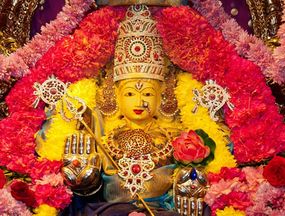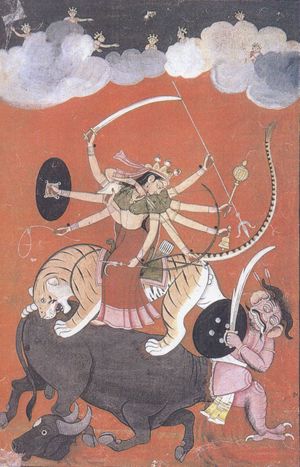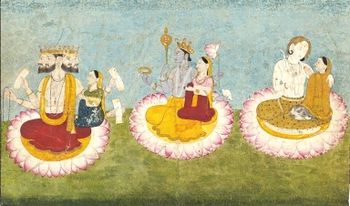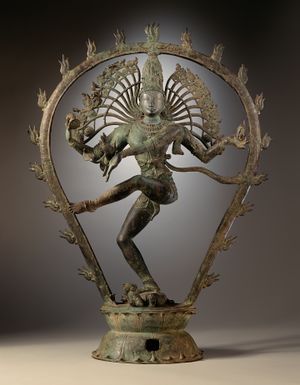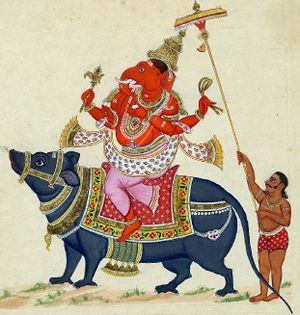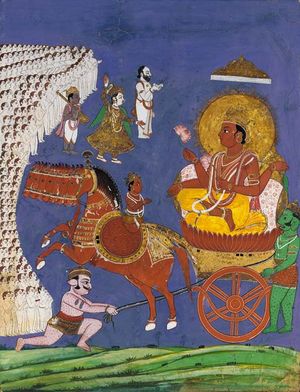الآلهة الهندوسية

| مقالات عن |
| الهندوسية |
|---|
 |
الهندوسية هي الديانة السائدة في شبه القارة الهندية. تضم الهندوسية ثلاثة طوائف رئيسية، الشايڤية، الڤشنوية والشاكتية، [1] والذي يعتبر أتباعه شيڤا، ڤشنو وشكتي هم الآلهة العظام، على التوالي. يطلق على الهندسي "الدين القديم" في العالم، ويشير الكثير من معتنقيها إلى الهندوسية على أنها "تشريع أبدي". (Sanātana Dharma).[2] القائمة التالية لكبار الآلهة الهندوسية وتليها قائمة للآلهة الهندوسية (والتي تشمل أشباه الآلهة).
The earliest Ardhanarishvara images are dated to the Kushan period, starting from the first century CE. Its iconography evolved and was perfected in the Gupta era. The Puranas and various iconographic treatises write about the mythology and iconography of Ardhanarishvara. Ardhanarishvara remains a popular iconographic form found in most Shiva temples throughout India, though very few temples are dedicated to this deity.
Ardhanarishvara represents the synthesis of masculine and feminine energies of the universe (Purusha and Prakriti) and illustrates how Shakti, the female principle of God, is inseparable from (or the same as, according to some interpretations) Shiva, the male principle of God. The union of these principles is exalted as the root and womb of all creation. Another view is that Ardhanarishvara is a symbol of Shiva's all-pervasive nature.
الرب الهندوسي
لم تكن الديانة الهندية التي حلت محل البوذية ديانة واحدة، كلا ولا كانت مقتصرة على كونها عقيدة دينية؛ بل كانت خليطاً من عقائد وطقوس لا يشترك القائمون بها في أكثر من أربع صفات؛ فهم يعترفون بنظام الطبقات وبزعامة البراهمة، وهم يقدسون البقرة باعتبارها تمثل الألوهية على نحو تمتاز به من سواها، وهم يقبلون قانون "كارما" وتناسخ الأرواح، وهم يضيفون إلى آلهتهم الجديدة آلهة الفيدات؛ ولقد كان بعض هذه العقائد أسبق من عبادة الطبيعة التي جاءت بها الفيدا، كما ظلت قائمة بعد زوال تلك العبادة، وأما بعضها الآخر فقد نشأ من أن البراهمة كانوا يغضون أبصارهم عن ضروب من الطقوس والآلهة والعقائد لم ينص عليها كتابهم المقدس، بل تناقضه روح الفيدا مناقضة ليست باليسيرة؛ فأتيحت الفرصة لتلك العقائد أن تنضج في وعاء الفكر الديني عند الهنود، ومضت في نضجها ذاك حتى في الفترة العابرة التي ارتفعت فيها البوذية إلى مكان السيادة العقلية في البلاد.
كان آلهة العقيدة الهندية يتميزون بكثرة أعضائهم الجسدية التي يمثلون بها على نحو غامض قدرتهم الخارقة في العلم والنشاط والقوة؛ "فبراهما" الجديد كان له أربعة وجوه، وكان لـ "كارتكيا" ستة وجوه، ولـ "شيفا" ثلاثة أعين، ولـ "هندرا" ألف عين؛ وكل إله عندهم تقريباً كان له أربع أذرعة(10) وعلى رأس هذه المجموعة الجديدة من الآلهة "براهما" الذي كان له من الشهامة ما أبعده عن الميل مع الهوى، وهو سيد الآلهة المعترف له بتلك السيادة، على الرغم من أنه مهمل في شعائر العبادة الفعلية إهمال الملك الدستوري في أوربا الحديثة؛ و"براهما" و"شيفا" و"فشنو" هم الثلاثة الآلهة (لا الثالوث) الذي يسيطرون على الكون، وأما "فشنو" فهو إله الحب الذي كثيراً ما انقلب إنسانا ليتقدم بالعون إلى بني الإنسان؛ وأعظم من يتجسد فيه "فشنو" هو "كرشنا" ، وهو في صورته "الكرشنية" هذه، قد ولد في سجن وأتى بكثير من أعاجيب البطولة والغرام، وشفى الصم والعمي، وعاون المصابين بداء البرص، وذاد عن الفقراء، وبعث الموتى من قبورهم؛ وكان له تلميذ محبب إلى نفسه، وهو "أرجونا" ، وأمام "أرجونا" تبدلت خلقة "فشنو" حالاً بعد حال؛ ويزعم بعض الرواة أنه مات مطعوناً بسهم، ويزعم آخرون أنه قتل مصلوباً على شجرة؛ وهبط إلى جهنم ثم صعد إلى السماء، على أن يعود في اليوم الآخر ليحاسب الناس أحياءهم وأمواتهم(11).
الحياة، بل الكون كله، لها في رأي الهندي ثلاثة وجوه رئيسية: الخلق، والاحتفاظ بالمخلوق، ثم الفناء؛ ومن ثم كان للألوهية عنده ثلاث صور: براهما الخالق، وفشنو الحافظ، وشيفا المدمر؛ تلك هي "الأشكال الثلاثة" التي يقدسها الهنود أجمعين ماعدا الجانتيين منهم ؛ والناس منقسمون بحبهم طائفتين: إحداهما تميل إلى ديانة فشنو، والأخرى إلى ديانة شيفا؛ وكلتا العقيدتين بمثابة الجارتين المسالمتين، بل قد تتقدم كلتاهما بالقرابين في معبد واحد(13)، والحكماء من البراهمة- تتبعهم الأكثرية العظمى من سواد الناس- تكرم الإلهين معاً بغير تمييز لأحدهما؛ أما الفشنيون الأتقياء فيرسمون على جباههم كل صباح بالطين الأحمر علامة فشنو، وهي شوكة ذات أسنان ثلاث؛ وأما الشيفيون المخلصون لعقيدتهم فيرسمون ثلاثة خطوط أفقية على جباههم برماد من روث البقر، أو يلبسون "اللنجا"- رمز عضو الذكورة- ويربطونه على أذرعتهم أو يعلقونه حول أعناقهم(14).
وعبادة "شيفا" هي من أقدم وأعمق وأبشع العناصر التي منها تتألف الديانة الهندية؛ فيقدم لنا "سير جون مارشل" "دليلاً لا يأتيه الباطل" على أن عقيدة "شيفا" كانت موجودة في "موهنجو- دارو"، متخذة أحياناً صورة شيفا ذي الرءوس الثلاثة، وأحياناً أخرى صورة أعمدة حجرية صغيرة، يزعم لنا أنها ترمز لعضو الذكورة على نحو ما ترمز له عندهم بدائلها في العصر الحديث؛ وهو يخلص من ذلك إلى نتيجة هي أن "العقيدة الشيفية أقدم عقيدة حية في العالم كله" .
واسم الإله- أعني كلمة شيفا- لفظة أريد بها التخفيف من بشاعة هذا الإله، فالكلمة شيفا معناها الحرفي "العطوف" مع أن شيفا في حقيقة الأمر إله القسوة والتدمير قبل كل شيء آخر؛ هو تجسيد لتلك القوة الكونية التي تعمل واحدة بعد أخرى، على تخريب جميع الصور التي تتبدى فيها حقيقة الكون- جميع الخلايا الحية وجميع الكائنات العضوية، وكل الأنواع، وكل الأفكار وكل ما أبدعته يد الإنسان، وكل الكواكب، وكل شيء؛ ولم يسبق الهنود شعب قط في شجاعتهم في مواجهة الحقيقة التي هي عدم ثبات الأشياء على صورها ووقوف الطبيعة من كل شيء موقف الحياد، مواجهة صريحة ؛ولم يسبقهم شعب قط في اعترافهم اعترافاً واضحاً بأن الشر يتوازن مع الخير، والهدم يساير الخلق خطوة خطوة، وأن ولادة الأحياء بأسرها جريمة كبرى عقابها الموت؛ فالهندي الذي تعذبه آلاف العوامل من عثرة الحظ والآلام، يرى في تلك الألوان من التعذيب أثراً ينم عن قوة نشيطة يمتعها- فيما يظهر- أن تحطم كل ما أنتجه براهما، وهو القوة الخالقة في الطبيعة؛ إن "شيفا" ليطرب راقصاً إذا ما سمع نغمة العالم فأدرك منها عالماً لا يني يتكون وينحل ويعود إلى التكون من جديد.
ولكن كما أن الموت عقوبة الولادة، فكذلك الولادة تخييب لرجاء الموت؛ فالإله نفسه الذي يرمز للتدمير، يمثل كذلك للعقل الهندي تلك الدفعة الجارفة نحو التناسل الذي يتغلب على موت الفرد باستمرار الجنس؛ وهذه الحيوية الخلاقة الناسلة شاكتي التي يبديها شيفا- أو الطبيعة- تتمثل في بعض جهات الهند، وخصوصاً في البنغال، في صورة زوجة شيفا، واسمها "كالي" (بارفاتي، أو أوما أو درجا) وهي موضع عبادة في عقيدة من العقائد الكثيرة التي تأخذ بمذهب "الشاكتي" هذا؛ ولقد كانت هذه العبادة- حتى القرن الماضي- وحشية الطقوس كثيراً ما تتضمن في شعائرها تضحية بشرية، لكن الآلهة اكتفت بعدئذ بضحايا الماعز(17)؛ وهذه الآلهة صورتها عند عامة الناس شبح أسود بفم مفغور ولسان متدل، تزدان بالأفاعي وترقص على جثة ميتة؛ وأقراطها رجال موتى، وعقدها سلسلة من جماجم، ووجهها وثدياها تلطخها الدماء(18) ومن أيديها الأربعة يدان تحملان سيفاً ورأساً مبتوراً، وأما اليدان الأخريان فممدودتان رحمة وحماية؛ لأن "كالي- بارفالي" هي كذلك الإله الأمومة كما أنها عروس الدمار والموت؛ وفي وسعها أن تكون رقيقة الحاشية كما في وسعها أن تكون قاسية، وفي مقدورها أن تبتسم كما في مقدورها أن تقتل؛ ولعلها كانت ذات يوم إلهة أماً في سومر، ومن ثم جاءت إلى الهند قبل أن تتخذ هذا الجانب البشع من جانبيها(19) ولاشك أنها هي وزوجها قد اتخذا أبشع صورة ممكنة لكي يلقيا الرعب في نفوس الرعاديد من عبادها فيحتشموا، أو قد تكون هذه البشاعة كلها قد أريد بها أن يلقي الرعب في نفوس العباد فيجودوا بالعطاء للكهنة .
تلك هي أعظم آلهة الهندوسيين، لكنا لم نذكر إلا خمسة من ثلاثين مليوناً من الآلهة تزدحم بها مقبرة العظماء في الهند؛ ولو أحصينا أسماء هاتيك الآلهة لاقتضى ذلك مائة مجلد؛ وبعضها أقرب في طبيعته إلى الملائكة، وبعضها هو ما قد نسميه نحن بالشياطين، وطائفة منها أجرام سماوية مثل الشمس، وطائفة منها تمائم مثل "لاكشمي" (إلهة الحظ الحسن)، وكثير منها هي حيوانات الحقل أو طيور السماء؛ فالهندي لا يرى فارقاً بعيداً بين الحيوان والإنسان، فالحيوان روح كما للإنسان، والأرواح تمضي دواماً متنقلة من بني الإنسان إلى بني الحيوان، ثم تعود إلى بني الإنسان مرة أخرى؛ وكل هذه الصنوف الإلهية قد نسجت خيوطها في شبكة واحدة لا نهاية لحدودها، هي "كارما" وتناسخ الأرواح؛ فالفيل مثلاً قد أصبح الإله "جانيشا" واعتبروه ابن شيفا(21)، وفيه تتجسد طبيعة الإنسان الحيوانية، وكانت صورته في الوقت نفسه تتخذ طلسماً يقي حامله من الحظ السيئ؛ كذلك كانت القردة والأفاعي مصدر رعب، فكانت لذلك من طبيعة الآلهة؛ فالأفعى التي تؤدي عضة واحدة منها إلى موت سريع، واسمها "ناجا" كان لها عندهم قدسية خاصة؛ وترى الناس في كثير من أجزاء الهند يقيمون كل عام حفلاً دينياً تكريماً للأفاعي، ويقدمون العطايا من اللبن والموز لأفاعي "الناجا" عند مداخل جحورها(22)؛ كذلك أقيمت المعابد تمجيداً للأفاعي كما هي الحال في شرقي ميسور، وهناك في هذه المعابد تسكن جموع زاخرة من الزواحف، ويقوم الكهنة على إطعامها والعناية بها(23)؛ وللتماسيح والنمور والطواويس والببغاوات، بل والفئران حقها من العبادة(24).
پارا براهمان
أدي پارا شاكتي
ديڤي أمبا (أما أو أمان)
تريمورتي وتريدڤي
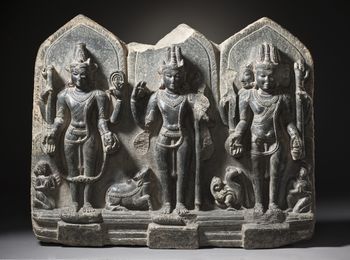
The concept of Triad (or Trimurti, Trinity) makes a relatively late appearance in Hindu literature, or in the second half of 1st millennium BC.[3] The idea of triad, playing three roles in the cosmic affairs, is typically associated with Brahma, Vishnu and Shiva (also called Mahesh); however, this is not the only triad in Hindu literature.[4] Other triads include Tridevi, of three goddesses – Lakshmi, Saraswati and Parvati in the text Devi Mahatmya, in the Shakta tradition, who further assert that Devi is the Brahman (Ultimate Reality) and it is her energy that empowers Brahma, Vishnu and Shiva.[3] The other triads, formulated as deities in ancient Indian literature, include Sun (creator), Air (sustainer) and Fire (destroyer); Prana (creator), Food (sustainer) and Time (destroyer).[3] These triads, states Jan Gonda, are in some mythologies grouped together without forming a Trinity, and in other times represented as equal, a unity and manifestations of one Brahman.[3] In the Puranas, for example, this idea of threefold "hypostatization" is expressed as follows,
They [Brahma, Vishnu, Shiva] exist through each other, and uphold each other; they are parts of one another; they subsist through one another; they are not for a moment separated; they never abandon one another.
— Vayu Purana، 5.17, Translated by Jan Gonda[3]
The triad appears in Maitrayaniya Upanishad, for the first time in recognized roles known ever since, where they are deployed to present the concept of three Guṇa – the innate nature, tendencies and inner forces found within every being and everything, whose balance transform and keeps changing the individual and the world.[4][5] It is in the medieval Puranic texts, Trimurti concepts appears in various context, from rituals to spiritual concepts.[3] The Bhagavad Gita, in verses 9.18, 10.21-23 and 11.15, asserts that the triad or trinity is manifestation of one Brahman, which Krishna affirms himself to be.[6] However, suggests Bailey, the mythology of triad is "not the influence nor the most important one" in Hindu traditions, rather the ideologies and spiritual concepts develop on their own foundations.[4] The triad, with Brahma creating, Vishnu preserving and Shiva destroying, balances the functioning of the whole universe.
تجسيدات الآلهة
التجسيدات العشرة لڤشنو
The most famous of the divine incarnations are Rama, whose life is depicted in the Ramayana, and Krishna, whose life is depicted in the Mahābhārata and the Bhagavata Purana. The Bhagavad Gita, which contains the spiritual teachings of Krishna, is one of the most widely read scriptures in Hinduism. Mohini is a female incarnation of Vishnu who appeared during the early struggle between the Deva and Asura.
- Matsya, the fish, appeared in the Satya Yuga. Represents the beginning of life.
- Kurma, the tortoise, appeared in the Satya Yuga. Represents a human embryo just growing tiny legs, with a huge belly.
- Varaha, the boar,appeared in the Satya Yuga. Represents a human embryo which is almost ready. Its features are visible.
- Narasimha, the Man-Lion (Nara = man, simha = lion), appeared in the Satya Yuga. Represents a newborn baby, hairy and cranky, bawling and full of blood.Regarded as the greatest and most powerful avatar.
- Vamana, the Dwarf, appeared in the Treta Yuga. Represents a young child.
- Parashurama, Rama with the axe, appeared in the Treta Yuga. Represents both an angry young man and a grumpy old man simultaneously.
- Rama, Sri Ramachandra, the prince and king of Ayodhya, appeared in the Treta Yuga. Represents a married man with children and depicts and ideal society. one man one one wife etc..,. Lord Rama is considered Purna avatar, which means full incarnation of Vishnu.
- Krishna, Krishna is considered Purna avatar, which means full incarnation of Vishnu. Represents a more realistic society. As chaotic as it looks there is clear demarcation between right and wrong.
- Buddha
- Kalki ("Eternity", or "time", or "The Destroyer of foulness"), who is expected to appear at the end of Kali Yuga, the time period in which we currently exist, though it has not happened yet. However, over the centuries many sects have believed their spiritual leader to be Kalki. For example, Ismaili Khojas, a Muslim group from Gujarat and Sindh who are followers of Aga khan, believe in the 10 incarnations of Vishnu.
Some consider Balarama, brother of Krishna, to be the eighth Avatar of Vishnu. They make Krishna the ninth avatar and delete Buddha.[7] Helmuth von Glasenapp attributed these developments to a Hindu desire to absorb Buddhism in a peaceful manner, both to win Buddhists to Vaishnavism and also to account for the fact that such a significant heresy could exist in India.[8] But other legend states that Balarama was an incarnation of Shesha and hence Buddha, founder of Buddhism, is the ninth avatar of Vishnu and Kalki the tenth one who is yet to come at the end of Kaliyuga.
الآلهة الهندوسية العمومية والإقليمية الرئيسية
| الاسم | أسماء أخرى | التصاوير أو الآلهة القرينة | الجغرافيا | الصورة | فن تصويري مبكر |
|---|---|---|---|---|---|
| ڤشنو | Nārāyana, Venkateshwara, Jagannatha Dattatreya |
Matsya, Kurma, Varāha, Nṛsimha, Vāmana, Parashurāma, Rāma, Kṛshna, Kalki, Vithoba, Gopāl, Balaram, Lady Mohini, Naraenten (那羅延天, Japan) | India, Nepal, Sri Lanka | 
|
2nd-century BC |
| شيڤا | Mahādeva, Pashupati, Tripurantaka, Vishwanatha, Dakshinamurthy, Kālāntaka, Bhairava, Rudra, Nataraja, Sadashiva Dattatreya |
Achalanatha (Japan)[9][10] | India, Nepal, Sri Lanka | 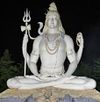
|
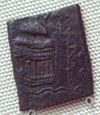 1st-century BC[11] |
| براهما | Prajāpati, Dattatreya | Bonten (Japan),[12] Phra Phrom (Thailand) |
الهند ونـِپال وسريلانكا وجنوب شرق آسيا | 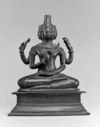
|
 6th-century AD |
| گانيشا | Ganapati, Vināyaka, Lambodara, Gajānana | Kangiten (اليابان) | India, Nepal, Sri Lanka | 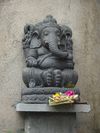
|
 7th-century AD |
| Kārtikeya | Skanda, Murugan | الهند وسريلانكا وماليزيا | 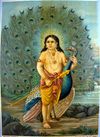
|
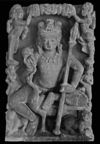 2nd-century BC | |
| پرڤاتي | Uma, Devi, Gauri, Durga, Kāli, Annapurna |
Umahi (烏摩妃, Japan) Dewi Sri (Indonesia)[13] |
India, Nepal, Sri Lanka | 
|
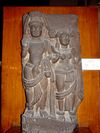 5th-century AD |
| لكشمي | Sri Devi, Gajalakshmi, Kamalāsanā | Sita, Rādhā, Kisshōten (Japan) Nang Kwak (Thailand)[14] |
India, Nepal, Sri Lanka | 
|
 1st-century BC |
| ساراسواتي | Vāgishvari, Vīnāpāni | Benzaiten (Japan), Biàncáitiān (China), Thurathadi (Myanmar), Suratsawadi (Thailand)[15] |
India, Nepal, Java, Bali, Sri Lanka | 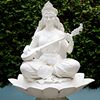
|
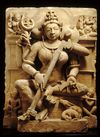 10th-century AD |
| دورگا | Pārvati, Kāli, Mahishāsuramardini |
Betari Durga (Indonesia)[16] | India, Nepal, Sri Lanka | 
|
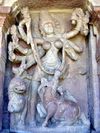 8th-century AD |
| كالي | Durga, Parvati | India, Nepal, Sri Lanka | 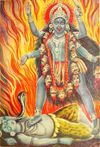
|
 12th-century AD | |
| Mariamman | Durga, Parvati | India (mostly in South India), Southeast Asia, Sri Lanka |
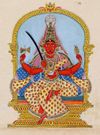
|
 10th-century AD | |
| هاريهارا (نصف ڤشنو - نصف شيڤا) | India, Sri Lanka | 
|
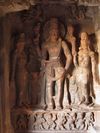 6th-century AD | ||
| أرداناريشڤارا (نصف شيڤا - نصف پرڤاتي) | India, Nepal, Sri Lanka | 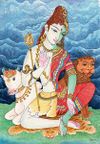
|
 1st-century AD |
آلهة متعلقة
الديڤا والديڤي
- Mitra, the patron god of oaths and of friendship,
- Varuṇa, the patron god of water and the oceans,
- Śakra, also called Indra, the king of gods, and the god of rains
- Dakṣa,
- Aṃśa,
- Aryaman,
- Bhaga, god of wealth
- Vivasvat, also called Ravi or Savitṛ,
- Tvāṣṭṛ, the smith among the gods,
- Pūṣan, patron god of travellers and herdsmen, god of roads,
- Dhātṛ, god of health and magic, also called Dhūti
- Yama, god of Dharma (moral ethics), of death and of justice.
Assistants of Indra and of Vishnu
- Agni the "Fire" god, also called Anala or "living",
- Vāyu the "Wind", the air god, also called Anila ("wind")
- Dyauṣ the "Sky" god, also called Dyeus and Prabhāsa or the "shining dawn"
- Pṛthivī the "Earth" god, also called Dharā or "support"
- Sūrya the "Sun" god, also called Pratyūsha, ("break of dawn", but often used to mean simply "light"), the Saura sectary worshipped Sūrya as their chief deity.
- Soma the "Moon" god, also called Chandra
- Aha ("pervading") or Āpa ('water' or ether), also called Antarikṣa the "Atmosphere" or "Space" god,
- Dhruva ("motionless") the Polestar, also called Nakṣatra the god of the "Stars",
They are the 8 personifications of god Rudra and have various names.
The Ashvins (also called the Nāsatyas) were twin gods. Nasatya is also the name of one twin, while the other is called Dasra.
الآلهة الشعبية
In their personal religious practices, Hindus may worship primarily one or another of these aspects, known as their Ishta Devata or Ishvara[17] (chosen deity).[18] The particular deities worshipped are a matter of individual preference,[19] although regional and family traditions can play a large part in influencing this choice.[20] Vaishnavism, Shaivism, Shaktism, and the Ganapatya sects of Hinduism states that Vishnu, Shiva, Devi (shakti), and Ganesha respectively equate to Brahman, and that all other deities are aspects of their chosen deity.[21]
Besides the Trimurti and Tridevi and aspects of the goddesses already mentioned, Shiva's sons Ganesha and Kartikeya, Vishnu's avatars like Rama and Krishna are popular deities.
Some deities have regional popularity. Regional forms of Vishnu include Jagannath, Vithoba and Venkateshwara.
عدد الآلهة
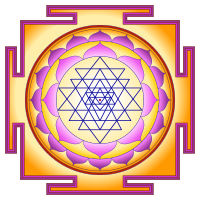 Sri Yantra symbolizing the goddess Tripura Sundari | |
| Yantras or mandalas (shown) are 3-D images.[22] In Tantra, a minority tradition in Hinduism,[23] they are considered identical with deity.[24] Similar tantric yantras are found in Jainism and Buddhism as well.[25] |
Yāska, the earliest known language scholar of India (~ 500 BC), notes Wilkins, mentions that there are three deities (Devas) according to the Vedas, "Agni (fire), whose place is on the earth; Vayu (wind), whose place is the air; and Surya (sun), whose place is in the sky".[26] This principle of three worlds (or zones), and its multiples is found thereafter in many ancient texts. The Samhitas, which are the oldest layer of text in Vedas enumerate 33 devas,[note 1] either 11 each for the three worlds, or as 12 Adityas, 11 Rudras, 8 Vasus and 2 Ashvins in the Brahmanas layer of Vedic texts.[30][31]
The Rigveda states in hymn 1.139.11,
ये देवासो दिव्येकादश स्थ पृथिव्यामध्येकादश स्थ ।
अप्सुक्षितो महिनैकादश स्थ ते देवासो यज्ञमिमं जुषध्वम् ॥११॥[32]
O ye eleven gods whose home is heaven, O ye eleven who make earth your dwelling,
Ye who with might, eleven, live in waters, accept this sacrifice, O gods, with pleasure.
– Translated by Ralph T. H. Griffith[33]
Gods who are eleven in heaven; who are eleven on earth;
and who are eleven dwelling with glory in mid-air; may ye be pleased with this our sacrifice.
– Translated by HH Wilson[34]— Rigveda 1.139.11
ملايين أم واحد أم وحدانية؟
Thirty-three divinities are mentioned in other ancient texts, such as the Yajurveda,[35] however, there is no fixed "number of deities" in Hinduism any more than a standard representation of "deity".[36] إلا أنه توجد رؤية شعبية تقول بوجود 33 كرورى (330 مليون) إله في الهندوسية.[37] Most, by far, are goddesses, state Foulston and Abbott, suggesting "how important and popular goddesses are" in Hindu culture.[36] No one has a list of the 33 category goddesses and gods, but scholars state all deities are typically viewed in Hinduism as "emanations or manifestation of genderless principle called Brahman, representing the many facets of Ultimate Reality".[36][37][38]
This concept of Brahman is not the same as the monotheistic separate God found in Abrahamic religions, where God is considered, states Brodd, as "creator of the world, above and independent of human existence", while in Hinduism "God, the universe, human beings and all else is essentially one thing" and everything is connected oneness, the same god is in every human being as Atman, the eternal Self.[38][39]
تعدد الآلهة
إن سر تعدد الآلهة هو عجز العقل الساذج عن التفكير فيما ليس مشخصاً؛ فأيسر عليه أن يفهم الأشخاص من أن يعقل القوى، وأن يفهم الإرادات من أن يتصور القوانين(28)، والظن عند الهندي هو أن حواسنا البشرية لا ترى من الحوادث التي تدركها سوى ظاهرها، ويعتقد أن وراء هذه الظواهر كائنات روحية لا حصر لعددها، يمكن إدراكها بالعقل لا بالحواس- على حد تعبير "كانت"؛ ولقد أدى تسامح البراهمة ذو المسحة الفلسفية، إلى الزيادة من ذخيرة آلهتهم حتى ازدادت كثرة على كثرة، وذلك أن الآلهة المحليين وآلهة القبائل المختلفة قد صادفت عند الهندي سهلاً ومرحباً، فقبلها وفسرها بأنها جميعاً تصور جوانب من آلهته الأصلية؛ فكل عقيدة يسمح لها بالدخول عندهم إن كان في مستطاعها أن تدفع الضريبة على ذلك؛ حتى كاد كل إله آخر الأمر أن يكون صورة أو صفة أو تجسيداً لإله آخر، ثم تناول العقل الهندي الرشيد كل هذه الآلهة فدمجها في إله واحد؛ هكذا تحول تعدد الآلهة إلى عقيدة بوحدة الوجود، أوشكت عندهم أن تكون توحيداً، والتوحيد بدوره أوشك أن يكون عندهم واحدية فلسفية؛ فكما يتوجه المسيحي الورع بالدعاء إلى العذراء، أو إلى قديس من آلاف القديسين ومع ذلك لا يتحول عن توحيده لله، بمعنى أنه لا يعترف إلا بإله واحد على أنه ذو الجلال الأسمى، فكذلك الهندي يتوجه بالدعاء إلى "كالي" أو "راما" أو "كرشنا" أو "جانيشا" دون أن يتطرق إلى ذهنه لحظة واحدة أن هذه آلهة لها السيادة العليا فترى بعض الهنود يتخذ من "فشنو" إلهاً أعلى، وبعضهم يتخذ من "شيفا" إلهاً أعلى، ويجعل فشنو أحد ملائكته؛ وإذا وجدت بين الهنود أقلية تعبد "براهما" فما ذلك إلا لأنه مجرد عن التشخص، ممتنع على الحواس، بعيد عن البشر، ولهذا السبب عينه ترى معظم الكنائس في البلاد المسيحية قد أقيمت تكريماً لمارية أو لأحد القديسين، وكان على المسيحية أن تنتظر حتى يجيئها فولتير فيقيم معبداً لله.
الديانة الهندوسية
البقرة المقدسة
 مقالة مفصلة: البقرة المقدسة
مقالة مفصلة: البقرة المقدسة
أكثر الحيوان قدسية عند الهندي هي البقرة، فنرى تماثيل الثيرة مصنوعة من كل مادة وفي شتى الأحجام تراها في المعابد والمنازل وميادين المدن؛ وأما البقرة نفسها فأحب الكائنات الحية جميعاً إلى الهنود، ولها مطلق الحرية في ارتياد الطرقات كيف شاءت، وروثها يستخدم وقوداً أو مادة مقدسة يتبركون بها، وبولها خمر مقدس يطهر كل ما في الجسم من نجاسة في الظاهر والباطن؛ ولا يجوز للهندي تحت أي ظرف أن يأكل لحمها أو أن يصطنع من جلدها لباساً يرتديه- فلا يصنع منه غطاء للرأس ولا قفازاً ولا حذاء؛ وإذا ماتت البقرة وجب دفنها بجلال الطقوس الدينية(25)، ولعل السياسة الحكيمة هي التي رسمت فيما مضى هذا التحريم احتفاظاً للزراعة بحيوان الجر حتى يسد حاجة السكان الذين يتكاثرون(26)، وقد بلغ عدد البقر اليوم ربع عدد السكان(27) ووجهة نظر الهندي في ذلك هي أنه ليس أبعد عن المعقول أن تشعر بالحب العميق للبقرة والمقت الشديد لفكرة أكلها، من أن تكن أمثال هذه المشاعر للحيوانات المستأنسة من قطط وكلاب، لكن الذي يبعث على السخرية المرة في الأمر هو عقيدة البراهمة بأن الأبقار لا يجوز ذبحها قط، وأن الحشرات لا يحل إيذاؤها قط، وأن الأرامل من النساء ينبغي أن يحرقن أحياء؛ فحقيقة الأمر هي أن عبادة الحيوان قد ظهرت في تاريخ الشعوب كلها، فإن جاز للإنسان أن يؤلمه الحيوان اطلاقاً، فالبقرة الرحيمة الهادئة حقها في هذا التقديس؛ ولا يجوز لنا أن نغلو في كبريائنا حين تأخذنا الدهشة لهذه المعارض الحيوانية من آلهة الهنود، فلنا كذلك إبليس عدن في صورة حية، والثور الذهبي في العهد القديم من الإنجيل، والسمك المقدس في سراديب الموتى، وحمل الله الوديع.
انظر أيضاً
- قائمة الآلهة الهندوسية
- قائمة الآلهة والمعابد الهندوسية
- الرمزية الهندوسية
- أساطير هندوسية
- Rigvedic deities
الهوامش
- ^ Nath 2001, p. 31.
- ^ Knott 1998, p. 5.
- ^ أ ب ت ث ج ح Jan Gonda (1969), The Hindu Trinity, Anthropos, 63/64, 1/2, pages 212-226
- ^ أ ب ت GM Bailey (1979), Trifunctional Elements in the Mythology of the Hindu Trimūrti, Numen, Vol. 26, Fasc. 2, pages 152-163
- ^ James G. Lochtefeld, Guna, in The Illustrated Encyclopedia of Hinduism: A-M, Vol. 1, Rosen Publishing, ISBN 9780823931798, page 265
- ^ Rudolf V D'Souza (1996), The Bhagavadgītā and St. John of the Cross, Gregorian University, ISBN 978-8876526992, pages 340-342
- ^ O'Flaherty, page 200.
- ^ von Glasenapp 1962 page 113, cited in O'Flaherty, page 206.
- ^ Jiro Takei and Marc P Keane (2001), SAKUTEIKI, Tuttle, ISBN 978-0804832946, page 101
- ^ Miyeko Murase (1975), Japanese Art: Selections from the Mary and Jackson Burke Collection, The Metropolitan Museum of Art (New York), ISBN 978-0870991363, page 31
- ^ M Chakravarti (1995), The concept of Rudra-Śiva through the ages, Motilal Banarsidass, ISBN 978-8120800533, pages 148-149
- ^ Robert Paine and Alexander Soper (1992), The Art and Architecture of Japan, Yale University Press, ISBN 978-0300053333, page 60
- ^ Joe Cribb (1999), Magic Coins of Java, Bali and the Malay Peninsula, British Museum Press, ISBN 978-0714108810, page 77
- ^ Jonathan Lee, Fumitaka Matsuoka et al (2015), Asian American Religious Cultures, ABC, ISBN 978-1598843309, page 892
- ^ Kinsley, David (1988), Hindu Goddesses: Vision of the Divine Feminine in the Hindu Religious Traditions, University of California Press, ISBN 0-520-06339-2, pages 94-97
- ^ Francine Brinkgreve (1997), Offerings to Durga and Pretiwi in Bali, Asian Folklore Studies Vol. 56, No. 2, pages 227-251
- ^ Explaining Hindu Dharma (2nd Edition). Vishwa Hindu Parishad (UK). 2002. p. 14. ISBN 09534354 - 0 - 7.
- ^ Werner (1994), p. 80.
- ^ Harman (2004), p. 106.
- ^ Harman (2004), p. 104.
- ^ "What is Hinduism?: Modern Adventures Into a Profound Global Faith". Himalayan Academy Publications. Retrieved 16 October 2011.
{{cite web}}:|first=has generic name (help);|first=missing|last=(help) - ^ Alain Daniélou (1991), The Myths and Gods of India, Princeton/Bollingen Paperbacks, ISBN 978-0892813544, pages 350-354
- ^ Serenity Young (2001), Hinduism, Marshall Cavendish, ISBN 978-0761421160, page 73
- ^ David R Kinsley (1995), Tantric Visions of the Divine Feminine: The Ten Mahāvidyās, Motilal Banarsidass, ISBN 978-8120800533, pages 136-140, 122-128
- ^ RT Vyas and Umakant Shah, Studies in Jaina Art and Iconography and Allied Subjects, Abhinav, ISBN 978-8170173168, pages 23-26
- ^ WJ Wilkins (2003), Hindu Gods and Goddesses, Dover, ISBN 978-0486431567, pages 9-10
- ^ Hermann Oldenberg (1988), The Religion of the Veda, Motilal Banarsidass, ISBN 978-8120803923, pages 23-50
- ^ AA MacDonell, Vedic mythology, p. PA19, في كتب گوگل, Oxford University Press, pages 19-21
- ^ Francis X Clooney (2010), Divine Mother, Blessed Mother, Oxford University Press, ISBN 978-0199738731, page 242
- ^ خطأ استشهاد: وسم
<ref>غير صحيح؛ لا نص تم توفيره للمراجع المسماةGeorge Williams 2008 pages 90, 112 - ^ خطأ استشهاد: وسم
<ref>غير صحيح؛ لا نص تم توفيره للمراجع المسماةmonier - ^ ऋग्वेद: सूक्तं १.१३९ Sanskrit, Wikisource
- ^ The Rig Veda/Mandala 1/Hymn 139 Verse 11, Ralph T. H. Griffith, Wikisource
- ^ The Rig Veda Samhita Verse 11, HH Wilson (Translator), Royal Asiatic Society, WH Allen & Co, London
- ^ See White Yajurveda verses 20.11 and 20.36, for example: Ralph Griffith, The texts of the white Yajurveda EJ Lazarus, pages 187, also 190, 132-135, 241
- ^ أ ب ت Lynn Foulston, Stuart Abbott (2009). Hindu goddesses: beliefs and practices. Sussex Academic Press. pp. 1–3, 40–41. ISBN 9781902210438.
- ^ أ ب خطأ استشهاد: وسم
<ref>غير صحيح؛ لا نص تم توفيره للمراجع المسماةlawrence78 - ^ أ ب Jeffrey Brodd (2003), World Religions: A Voyage of Discovery, Saint Mary's Press, ISBN 978-0884897255, page 43
- ^ Christopher John Fuller (2004), The Camphor Flame: Popular Hinduism and Society in India, Princeton University Press, ISBN 978-0691120485, pages 30-31, Quote: "Crucial in Hindu polytheism is the relationship between the deities and humanity. Unlike Jewish, Christian and Islamic monotheism, predicated on the otherness of God and either his total separation from man and his singular incarnation, Hinduism postulates no absolute distinction between deities and human beings. The idea that all deities are truly one is, moreover, easily extended to proclaim that all human beings are in reality also forms of one supreme deity - Brahman, the Absolute of philosophical Hinduism. In practice, this abstract monist doctrine rarely belongs to an ordinary Hindu's statements, but examples of permeability between the divine and human can be easily found in popular Hinduism in many unremarkable contexts".
المصادر
- Daniélou, Alain (1991) [1964]. The myths and gods of India. Inner Traditions, Vermont, USA. ISBN 0-89281-354-7.
- Fuller, C. J. (2004). The Camphor Flame: Popular Hinduism and Society in India. Princeton University Press, New Jersey. ISBN 0-691-12048-X.
- Harman, William, "Hindu Devotion". In: Contemporary Hinduism: Ritual, Culture, and Practice, Robin Rinehard, ed. (2004) ISBN 1-57607-905-8.
- Kashyap, R.L. Essentials of Krishna and Shukla Yajurveda; SAKSI, Bangalore, Karnataka ISBN 81-7994-032-2.
- Keay, John (2000). India, a History. New York, United States: Harper Collins Publishers. ISBN 0-00-638784-5.
{{cite book}}: Invalid|ref=harv(help) - Pattanaik, Devdutt (2009). 7 Secrets from Hindu Calendar Art. Westland, India. ISBN 978-81-89975-67-8.
- Swami Bhaskarananda, (1994). Essentials of Hindusim. (Viveka Press) ISBN 1-884852-02-5.
- Vastu-Silpa Kosha, Encyclopedia of Hindu Temple architecture and Vastu. S.K.Ramachandara Rao, Delhi, Devine Books, (Lala Murari Lal Chharia Oriental series) ISBN.978-93-81218-51-8 (Set)
- Werner, Karel A Popular Dictionary of Hinduism. (Curzon Press 1994) ISBN 0-7007-0279-2.
قراءات إضافية
- Chandra, Suresh (1998). Encyclopaedia of Hindu Gods and Goddesses. Sarup & Sons, New Delhi, India. ISBN 81-7625-039-2.
- Pattanaik, Devdutt (2003). Indian mythology: tales, symbols, and rituals from the heart of the Subcontinent. Inner Traditions / Bear & Company. ISBN 0-89281-870-0.
- Kinsley, David. Hindu Goddesses: Vision of the Divine Feminine in the Hindu Religious Traditions. Motilal Banarsidass, New Delhi, India. ISBN 81-208-0379-5.
وصلات خارجية
- A chart of the main Hindu deities (مع صور)
خطأ استشهاد: وسوم <ref> موجودة لمجموعة اسمها "note"، ولكن لم يتم العثور على وسم <references group="note"/>
- CS1 errors: generic name
- CS1 errors: missing name
- Short description is different from Wikidata
- Portal-inline template with redlinked portals
- Pages with empty portal template
- Articles with hatnote templates targeting a nonexistent page
- Articles using infobox templates with no data rows
- آلهة هندوسية
- أساطير هندوسية
- Forms of Shiva
- Forms of Parvati
- Androgyny
- Transgender topics and religion
- Intersex in religion and mythology
